29+ Sample Exit Interview Questionnaire Templates
-
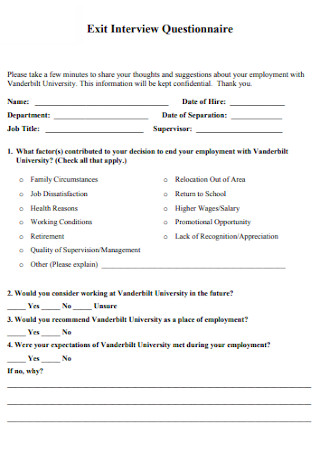
Exit HR Interview Questionnaire
download now -
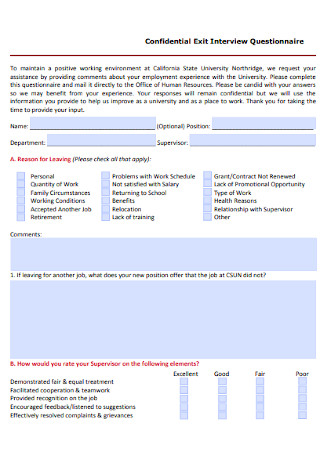
Confidential Exit Interview Questionnaire
download now -
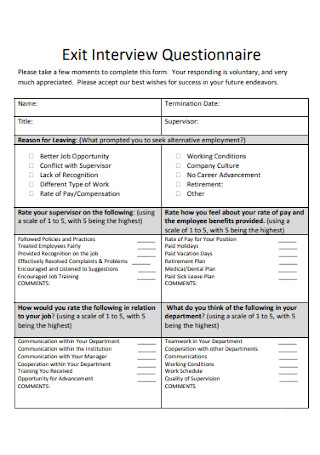
Exit Interview Questionnaire Example
download now -
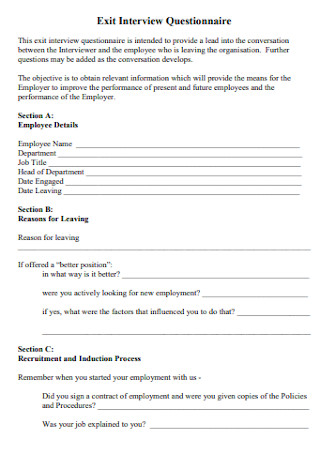
Exit Interview Training Questionnaire
download now -
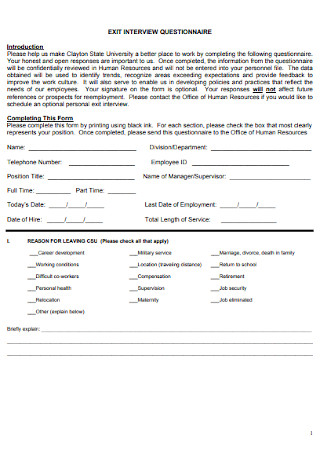
Sample Exit Interview Questionnaire Template
download now -
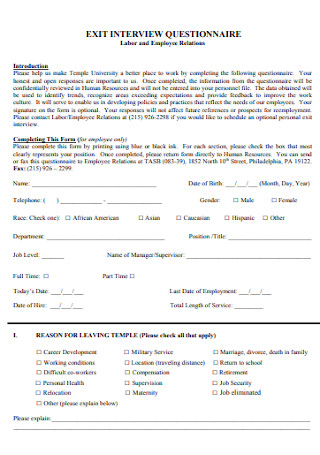
University Exit Interview Questionnaire
download now -
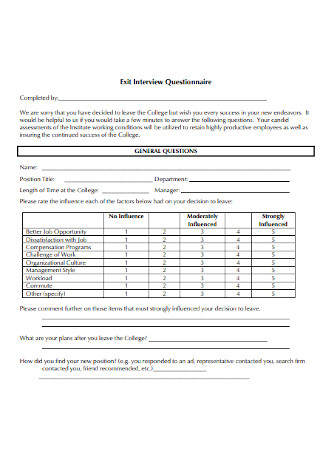
College Exit Interview Questionnaire
download now -
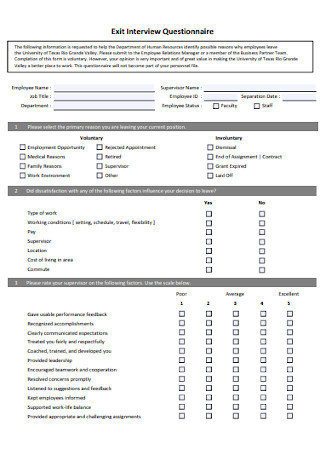
University Exit Interview Questionnaire Template
download now -

Faculty Exit Interview Questionnaire
download now -
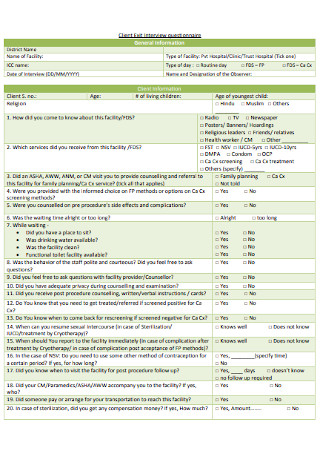
Client Exit Interview Questionnaire
download now -
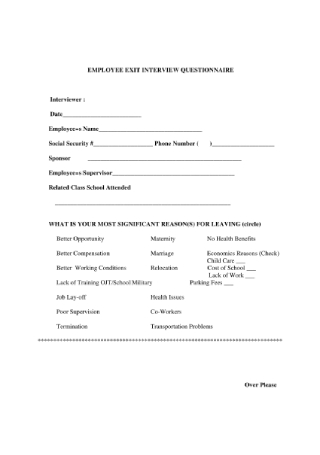
Employee Exit Interview Questionnaire
download now -

Exit Interview Questionnaire Form
download now -
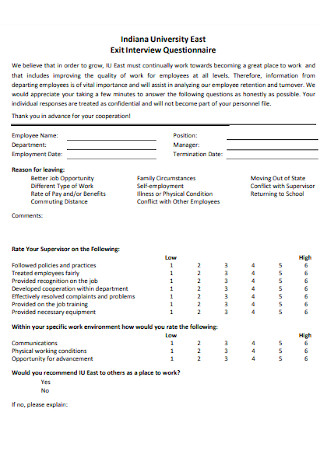
University East Exit Interview Questionnaire
download now -

Exit Employee Interview Questionnaire
download now -
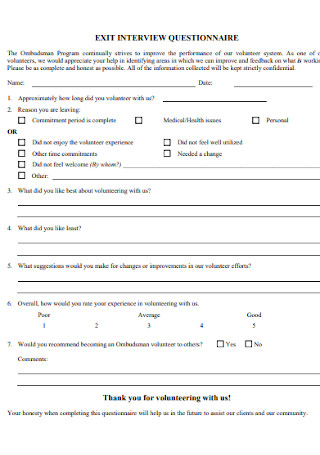
Volunteer Exit Interview Questionnaire
download now -
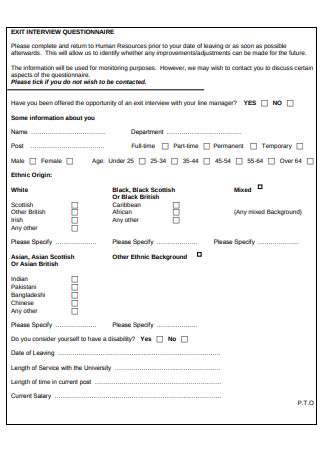
Exit Interview Questionnaire Template
download now -

Exit Extension Interview Questionnaire
download now -
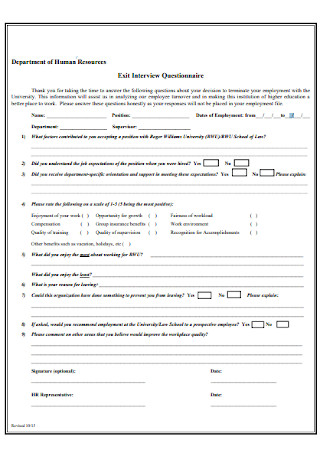
Department of HR Exit Interview Questionnaire
download now -
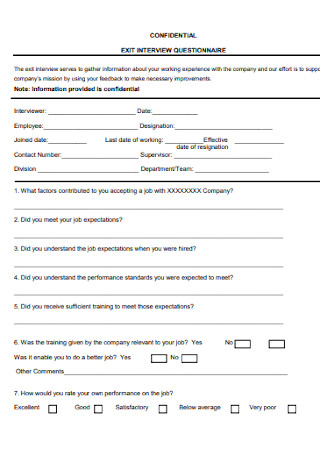
Confidential Exit Interview Questionnaire Template
download now -
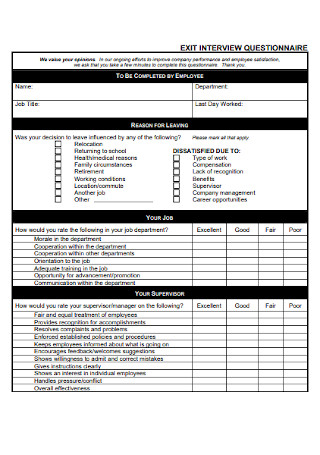
Exit Interview Questionnaire Format
download now -

Employment Exit Interview Questionnaire
download now -
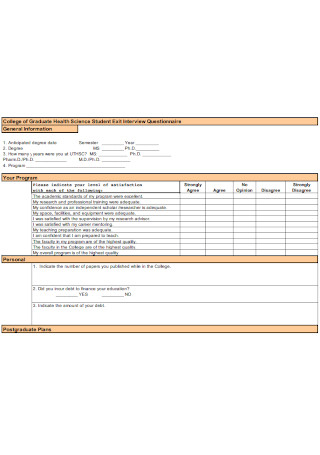
Student Exit Interview Questionnaire
download now -

Volunteer Exit Interview Questionnaire Template
download now -

Sample Client Exit Interview Questionnaire
download now -
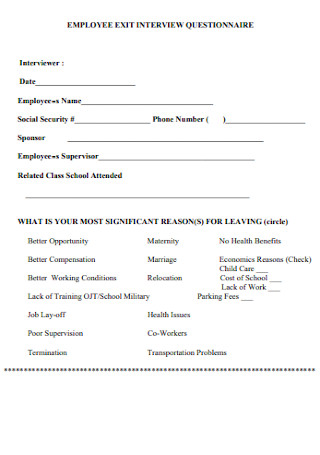
Basic Employee Exiit Interview Questionnaire
download now -
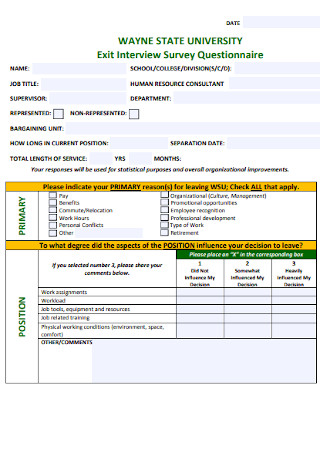
Exit Interview Survey Questionnaire
download now -
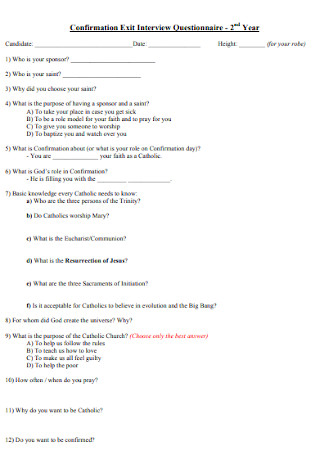
Confirmation Exit Interview Questionnaire
download now -
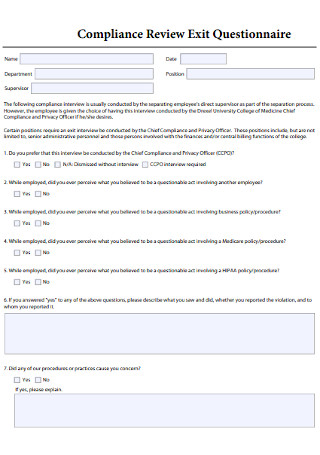
Compliance Review Exit Interview Questionnaire
download now -
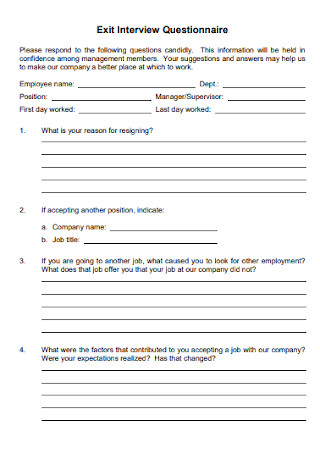
Standard Exit Interview Questionnaire
download now -
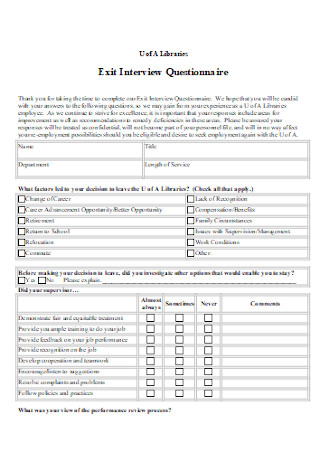
Libraries Exit Interview Questionnaire
download now
FREE Exit Interview Questionnaire s to Download
29+ Sample Exit Interview Questionnaire Templates
What Is an Exit Interview Questionnaire?
The Elements of an Exit Interview Questionnaire
How to Make an Exit Interview Questionnaire
FAQs
What are the other names for an exit interview questionnaire?
When should exit interview questionnaires be filled out?
Can employees decline an exit interview?
How long should an exit interview be?
What Is an Exit Interview Questionnaire?
If you get a job interview in applying to a company, then an exit interview is also imperative in leaving the business. And there will be a set of questions to ask which departing employees must answer. Instead of raising random questions during the interview, it is better to prepare it using an interview sheet or exit interview questionnaire. This questionnaire may be processed as verbal questions or a survey, and questions would focus on inquiring about the departing worker’s reasons for leaving and overall employment experience. The exit interview questionnaires can also be used in two ways: (1) to be filled out by the soon-to-be ex-employee, and (2) to be used as an interviewer checklist.
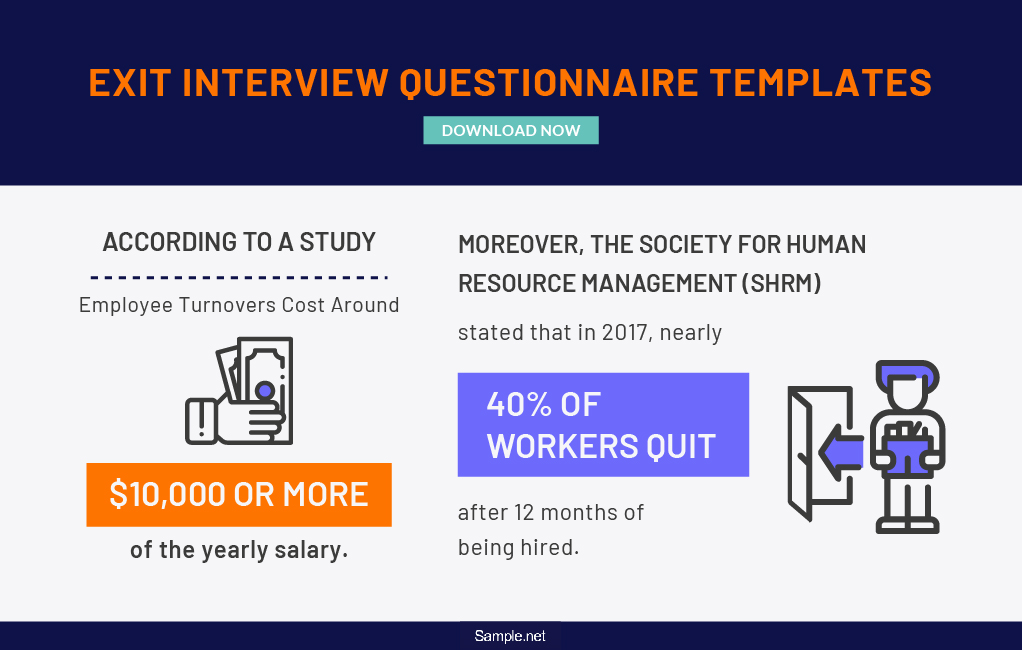
According to a study, employee turnovers cost around $10,000 or more of the yearly salary.
Moreover, the Society for Human Resource Management (SHRM) stated that in 2017, nearly 40% of workers quit after 12 months of being hired.
Why Are Exit Interview Questionnaires Fundamental?
An exit interview questionnaire is vital as an exit report. If employees leave the company without undergoing the termination process, it would be unprofessional for the employees’ part; hence, it is a bad reflection if other businesses know about that from such workers. A questionnaire works like any survey where it takes a few minutes to complete only. So, it should not be that bothersome for departing workers. And aside from employees who wish to separate from business, exit interview forms are relevant for students in school, members of an association, or anyone in a relationship or organization.
What also makes exit interview questionnaires essential is how they are pre-formatted already. The questionnaire marks your reliable checklist when you need aid to remember the essential questions to ask then. What is even better? The purpose of a questionnaire form is not limited to asking only; it gathers answers that are useful for insights. You acquire learnings from a worker’s reason behind a resignation or retirement. More so, a manager learns how to take action for the concerns left when an employee leaves.
Who Prepares Exit Interview Questionnaires?
Generally, the exit interview questionnaire is prepared by anyone from HR. Aside from preparing the form, they are responsible for raising concerns too. But in other cases, HR can assign other people as the interviewer as long as those interviewers know some background about the soon-to-be ex-workers. So down from the exit interview planning down to the actual interview, HR must know what to do. Otherwise, failing to ask the most important questions might not gather the best insights.
The Elements of an Exit Interview Questionnaire
What consists of an exit interview questionnaire? Indeed, the document’s definition and purpose are clear. But it is also significant to determine the common elements found in such questionnaires. This section will introduce you to six of the typical elements of the exit interview questionnaires.
How to Make an Exit Interview Questionnaire
“The goal of exit interviewing is to learn from the past, so you don’t repeat the mistakes in the future,” said Michael Bergdahl. And the renowned author’s statement tells us to take exit interviews seriously. Reports even confirmed that in 2017, 40% of workers quit after 12 months of being hired. And companies that keep on losing employees should lessen that risk. Thankfully, exit interview questions are the start of that investigation. But if you cannot make the questionnaire correctly, results might fail. So in this segment, we will guide you on the right way to make an exit interview questionnaire in just five easy steps.
Step 1: Download a Template
If you think making an exit interview questionnaire is stressful, then you are wrong. Have you peeked into our collection of exit interview questionnaire templates already? As you can see, there are many templates to choose from. And they are all going to lessen the hassle of making questionnaires since they are pre-formatted. There is no need to begin from scratch. Select the best template until you can fill out the details and complete the questionnaire.
Step 2: Follow Your Preferred Format
Aside from getting downloadable templates, you can bet that they are editable too. Think about how you want to present the questionnaire until you can start adjusting the template’s format. Remember that in questionnaires, it is not simply about enumerating all questions to ask. There should be a format. Decide the margins, font styles, font sizes, number of pages, and more. Besides writing words, you can also add tables and charts anyway.
Step 3: Ask the Right Questions
Have you decided on the questions to put inside the form already? Work on that first. Be sure that the most important questions relating to the leaver’s overall experience and reasons to leave will be included. Have you applied to another company? If so, is it the same job description? Such examples and other followup questions are welcome here. But, be sure to think about relevance. There is no need to ask insignificant or inane questions that are not part of exit interviews.
Step 4: Be Specific
A common mistake for some exit interview questions is when everything is too long. Remember that no leaver would want to answer a questionnaire containing numerous pages too. A one-page document will suffice already. Just be sure to be specific with your words so you can save space. Also, shorten some words that can be shortened. And maybe different questions ask the same thing. So, get rid of the other one.
Step 5: Observe an Easy-to-Follow Questionnaire
Think of being in the leaver and interviewer’s shoes in using the questionnaire. Do you think the whole thing is easy to follow? If not, then make some changes that make things easier. Perhaps, you add instructions to the document as a guide on whoever uses the sheet. And do not use very complicated words. Indeed, it is good to sound fancy, but this is not about impressing people with your vocabulary. Focus on ensuring most people would understand the words, questions, and instructions written there. And once you are confident with the result, launch the questionnaire.
FAQs
What are the other names for an exit interview questionnaire?
An exit interview questionnaire can be referred to as the company exit interview questionnaire, exit interview survey, performance review questionnaire, exit report interview sheet, and many more. Despite having different names, they are all still similar in function—asking the leaver about the important questions before leaving the organization.
When should exit interview questionnaires be filled out?
It is common for departing employees to fill out the exit interview questionnaire before leaving the organization or the actual interview. In an interview, interviewers will use the leaver’s answers for reference. But in other cases, some people can answer the document after leaving the business, especially if they are busy on the last workday.
Can employees decline an exit interview?
Yes, they can decline an exit interview. But, it is discouraged. Declining can be seen as a rude act. Remember that exit interviews aim to end things properly, so it should not be ignored. If an employee is busy or sick, it is okay to reschedule rather than not meet.
How long should an exit interview be?
The length of time for exit interviews varies. It depends on the HR or how many things will be tackled with the departing worker. Generally, an hour is enough, but some may reach 90 minutes. And it will be safer to schedule an early appointment if it looks like the interview takes long.
If you summarize an exit interview questionnaire, it is just the opposite of a new hire questionnaire. Expect to evaluate the final say of departing workers to gain understanding and end business relationships on a positive note. There is no need for employers to threaten or force employees to stay anyway since the right approach is to improve business operations that would make employees stay. You will eventually find that solution to make workers stay from the answers acquired in exit interviews. And you can do so beginning with an exit interview questionnaire.
